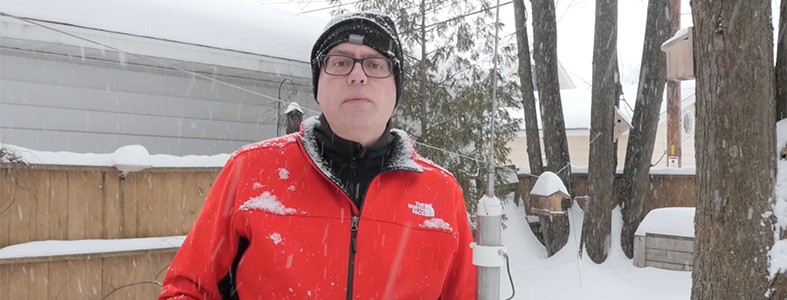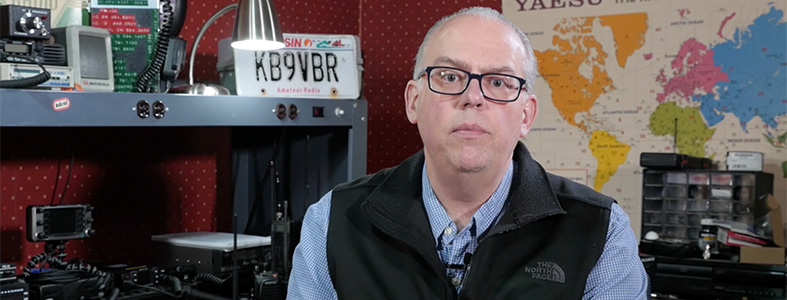It’s February so we’re half way through winter. The days are getting longer and the sun warmer. In no time I’ll be pulling the trailer out of the garage and planning some outdoor adventures. In the meantime I’ll have to contend with indoor operations. Please stay tuned to the end for an update on what will be happening in the coming week. But first‚ the questions.
I’ve got a few miscellaneous‚ but quite interesting‚ questions here and then we’ll move into a more in depth talk on my recent video on if snow affects your vertical antenna performance.
Gill asks the following question about cross band repeater operation:
Will using a repeater that is linked to say 20 other repeaters through out the state be an issue?
No‚ it shouldn’t be an issue. You can cross band into a linked repeater system just like any other repeater. I’ve crossbanded on linked repeater systems with fine results. Just remember to wait about a second when you key up before speaking so that the crossband and the links have time to engage. But on a side note: not all repeater owners may like or appreciate cross band operation on their system. Sometimes the extra noise of the squelch tail that common with a cross band can get compounded through a linked system‚ so if you plan to use a cross band on a repeater on regular basis‚ you should first ask permission of the repeater owner or trustee.
Another Gil asked a question about using a DMR Hotspot
Should I leave my DVMEGA Hotspot powered up all the time? (Most of the time it is not Used)
I leave mine on all the time‚ as the energy consumption is quite low. If you don’t want the hotspot to be transmitting when you aren’t listening to it‚ you can disconnect from the active talk group. This is done by transmitting a briefly to talkgroup code 4000. To do so‚ program talk group 4000 into the contact list in your radio and then briefly key up on that talkgroup to send the code to the hotspot. It will disconnect from the active talkgroup.
Sage just got his Technician License and is asking about his Certificate of Successfully Completed Exam
Can you explain the meaning of the statement on the CSCE Technician paperwork…”CREDIT FOR ELEMENTS PASSED VALID FOR 365 DAYS”. Isn’t the license good for 10 years? Or is there something that needs to be done in that one year window?
 That phrase is a holdover from the days when passing a morse code test was required for General and Extra class licenses. Back then you could have passed your Element 3 General written test yet failed the Element 1 code test. Your certificate for successfully completed exam (CSCE) would give you a 365 day window to pass the code test and complete the upgrade. Nowadays since code isn’t required‚ the exam credit is a moot point as you either pass and upgrade or fail and not.
That phrase is a holdover from the days when passing a morse code test was required for General and Extra class licenses. Back then you could have passed your Element 3 General written test yet failed the Element 1 code test. Your certificate for successfully completed exam (CSCE) would give you a 365 day window to pass the code test and complete the upgrade. Nowadays since code isn’t required‚ the exam credit is a moot point as you either pass and upgrade or fail and not.
Moving on; I received a lot of great advice and information pertaining to my recent video on if snow can affect the ground radial performance of a vertical antenna system. If you remember my results from my initial video the testing was inconclusive- so I asked the viewers if they had more information and resources. The hive-mind responded and I thank everyone that took the time to give me direction on where to look for published information. I’ll follow up on a few questions but this isn’t the end of the subject as I’m going to continue testing and researching for a more definitive answer.
Starting out- Ross says:
I always enjoy your videos!!!! One question: With your wolf river antenna system, how many radials are you using and are they cut at specific lengths for your operating frequencies? Also, does the antenna benefit from being grounded?
I’m not sure if I mentioned in the video on what I’m using for radials but I have three ground radials each 32 feet in length. At this length they tend to work best at the lower lengths but can be a bit finicky 20 meters and above. I do the same thing when I use the antenna portable and will roll up the radials to shorten them for a better match on the higher bands. Unfortunately I can’t do that when they get buried in snow and ice. For radial length‚ a general rule is that if they are non-resonant on all the frequencies you wish to work on‚ they will work acceptably on those frequencies.
 As for grounding‚ I don’t really think additional grounding is necessary if you are already using a ground radial network. I didn’t ground the antenna; although I suppose with it mounted on a fence post there would be a certain amount of grounding. But it’s tenuous as the post is also painted.
As for grounding‚ I don’t really think additional grounding is necessary if you are already using a ground radial network. I didn’t ground the antenna; although I suppose with it mounted on a fence post there would be a certain amount of grounding. But it’s tenuous as the post is also painted.
We’ll talk more about grounding as Claude brings up the following point:
This Snow subject and radio waves is something I deal with more on Military excercises. You lose transmitting and receiving strength.
First of all to do this test for the sake of this viewers question, an antenna that is tested before a snow fall is grounded. Now try this same test with the antenna not grounded into the earth. But sitting on the snow. Because snow is Distilled water it can not conduct electrical current no matter if it is wet or dry snow. This is why we have such a problem in snow without a ground plane.
My buddy Joe‚ who also happens to be an electrician says:
Should actually be worse for ground radiation. That’s why Wisconsin requires two ground rods at a service. When the frost runs deep the first 4 feet of ground won’t conduct like thawed ground. He also reminded me that RF and 60 hz electricity act similarly.
So if you want to take advantage of ground wave propagation‚ and ground wave would be crucial for medium frequency propagation like 160 meters‚ then a suitable ground is paramount for cold weather environments.
In fact‚ another Joe reminds us that AM broadcast band signal ground wave signal strength always appears stronger in the winter months vs. the warmer summer months. If you have an AM broadcast band receiver with a signal strength meter you can note either bar or number readings from summer and then in winter. In every case, the reading are always higher in the winter especially with snow and cold weather. It’s always been my assumption that medium wave ground conductivity (including 160 Mtrs) is better in the winter. Since your doing your tests on 40 Mtrs, the effects on snow and cold may be less noticeable.
Most of the research I found online was geared towards AM and medium frequency operations and not so much the HF bands. But I think the reason is that there is that the commercial operations on the AM band requires a station that operates in a predictable manner.
Which brings me to another commend from Claude:
An excellent source of information is MCRF 3-403B Radio Operators Handbook Refer to Chapter 6-6 which explains winter operations very well.
Thanks for pointing me to the resource. The Radio Operators Handbook from the US Marine Corp has a wealth of information for the HF portable operator. One thing I’ll point out is that it’s written in a very practical manner so you won’t find much in regards to theoretical reasoning‚ but still the manual writes about cold weather operation:
Because of permafrost and deep snow, it is difficult to establish good electrical grounding in extremely cold areas. The conductivity of frozen ground is often too low to provide good ground wave propagation. To improve ground wave operation, use a counterpoise to offset the degrading effects of poor electrical ground conductivity. Remember to install a counterpoise high enough above the ground so that it will not be covered by snow.
I’ll put a link to this book in the video description below. Reading through it‚ I think it will be an invaluable resource to the portable operator.
And finishing up‚ JP mentions:
Hi Michael, would love to see a redo of these tests with bare (non-coated) copper or aluminum wire to allow contact with rain/snow/ice etc.
I’m not done with this subject‚ so I’m going to continue testing and will share my results along the way. I’ll repeat these tests with bare wire radials. I have a bunch of aluminum electric fence wire that should work well as a radial network. So I’ll see what kind of results I get. I also plan to test and take readings on other bands: notably 20 and 80 meters in addition to 40 meters. Finally I’ll also redo my tests in the spring after the snow melts and the ground thaws but before the leaves sprout on the trees. So you can expect a followup report later in the spring.
If you have any thing else I should do or try: leave it in the comments below. I’d love to hear them
Before we close down this video I just want to share what’s coming up for the month. I plan to have a followup on my video on APRS with the Yaesu FT3DR. I received enough questions on that to fill up an entire video. Last week I was volunteering at a sled dog race in Northern Wisconsin and I’ll have a video on how that went. And I recently received a question about power supplies so something on that will be coming too. If you have a subject that you’d like to see‚ please leave it in the comments below and I’ll add it to the list.

Recent Comments